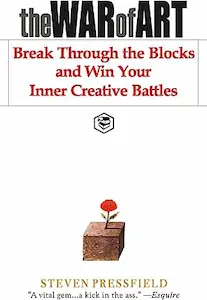The War of Art - Summary
Steven Pressfield

Introduction
“The War of Art” by Steven Pressfield is a book that delves into the concept of resistance and how it affects our ability to create and achieve our goals. Pressfield argues that resistance is the biggest obstacle we face in our pursuit of success, and that overcoming it is essential if we want to live a fulfilling life.
In this book summary, we’ll take a closer look at the key themes and ideas presented in “The War of Art,” and explore how they can be applied to our own lives.
What is Resistance?
The central concept of “The War of Art” is resistance, which Pressfield defines as the force that opposes our ability to create, achieve, and fulfill our potential. Resistance can take many forms, including procrastination, self-doubt, fear, and distraction.
Pressfield argues that resistance is a natural part of the creative process, and that it is something that we all experience to some degree. However, he also believes that resistance is something that can be overcome, and that doing so is essential if we want to achieve our goals.
The Three Forms of Resistance
According to Pressfield, there are three main forms of resistance that we encounter in our lives:
Resistance to Work - This is the most common form of resistance, and it manifests as procrastination, distraction, and avoidance. It’s the voice in our head that tells us to put off our work until tomorrow, or to check our email one more time before starting a project.
Resistance to Criticism - This type of resistance is rooted in our fear of failure and rejection. It’s the voice in our head that tells us not to share our work with others, or to hold back our ideas because we’re afraid of what others might think.
Resistance to Change - This form of resistance is often the most difficult to overcome, as it requires us to step outside of our comfort zone and take risks. It’s the voice in our head that tells us to stick with what we know, even if it’s not working for us.
The Importance of Discipline
Pressfield argues that the key to overcoming resistance is discipline. He believes that we need to establish a routine and stick to it, even when we don’t feel like it. By doing so, we train ourselves to ignore the voice of resistance and focus on our goals.
Discipline, according to Pressfield, is not about punishing ourselves or denying ourselves pleasure. Instead, it’s about creating a structure that allows us to be productive and achieve our goals.
The Role of Fear
Fear is a common form of resistance, and it’s something that we all experience at some point in our lives. Pressfield argues that fear is not something that we can eliminate entirely, but rather something that we need to learn to manage.
One of the key ways to manage fear, according to Pressfield, is to reframe it as a positive force. Instead of seeing fear as something that holds us back, we can view it as a sign that we’re on the right track. When we feel fear, it’s often a sign that we’re pushing ourselves outside of our comfort zone and taking risks.
The Importance of Starting
One of the biggest challenges that we face when it comes to overcoming resistance is getting started. Pressfield argues that the hardest part of any project is often the beginning, and that we need to push through our initial resistance in order to make progress.
To overcome this initial resistance, Pressfield recommends starting small. Instead of trying to tackle a huge project all at once, break it down into smaller, more manageable tasks. By doing so, you’ll build momentum and make progress, which will help to motivate you to keep going.
The Power of Persistence
Persistence is another key factor in overcoming resistance, according to Pressfield. He argues that we need to be willing to put in the time and effort required to achieve our goals, even when it’s difficult or uncomfortable.
One of the key ways to cultivate persistence, according to Pressfield, is to focus on the process rather than the outcome. When we focus too much on the end result, we can become discouraged if we don’t see immediate progress. However, by focusing on the process and the small steps that we’re taking, we can build momentum and stay motivated.
The Importance of Self-Validation
Another common form of resistance is self-doubt. Pressfield argues that we need to learn to validate ourselves, rather than relying on external validation from others.
To do this, Pressfield recommends focusing on the work itself, rather than the outcome. Instead of worrying about what others will think of our work, we should focus on creating something that we’re proud of. By doing so, we can build our confidence and overcome our self-doubt.
Conclusion
“The War of Art” is a powerful book that offers valuable insights into the nature of resistance and how we can overcome it. By understanding the different forms of resistance that we encounter, and by cultivating discipline, persistence, and self-validation, we can break through our barriers and achieve our goals.
Pressfield’s message is a powerful one, and it’s something that can be applied to all areas of our lives. Whether we’re trying to write a novel, start a business, or simply live a more fulfilling life, “The War of Art” offers valuable guidance and inspiration.